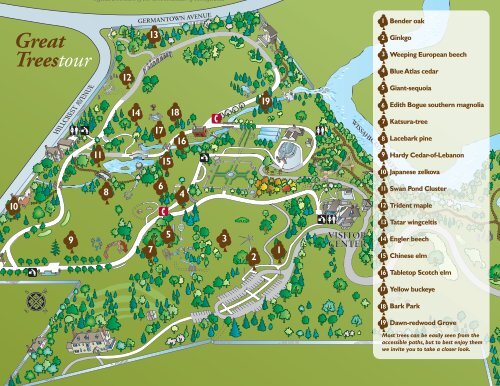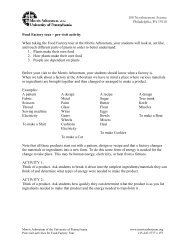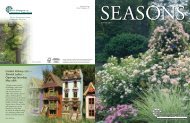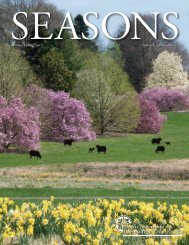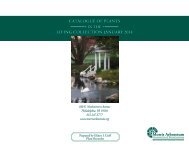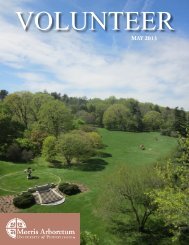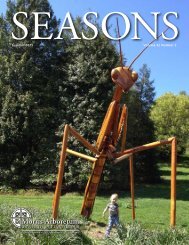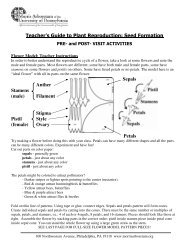Great Treestour - Business Services - University of Pennsylvania
Great Treestour - Business Services - University of Pennsylvania
Great Treestour - Business Services - University of Pennsylvania
Create successful ePaper yourself
Turn your PDF publications into a flip-book with our unique Google optimized e-Paper software.
<strong>Great</strong><br />
<strong>Treestour</strong><br />
10<br />
9<br />
11<br />
8<br />
12<br />
13<br />
14 18<br />
7<br />
17<br />
6<br />
15<br />
5<br />
16<br />
4<br />
3<br />
2<br />
19<br />
1<br />
1<br />
2<br />
3<br />
4<br />
5<br />
6<br />
7<br />
8<br />
9<br />
10<br />
11<br />
12<br />
13<br />
14<br />
15<br />
16<br />
17<br />
18<br />
Bender oak<br />
Ginkgo<br />
Weeping European beech<br />
Blue Atlas cedar<br />
Giant-sequoia<br />
Edith Bogue southern magnolia<br />
Katsura-tree<br />
Lacebark pine<br />
Hardy Cedar-<strong>of</strong>-Lebanon<br />
Japanese zelkova<br />
Swan Pond Cluster<br />
Trident maple<br />
Tatar wingceltis<br />
Engler beech<br />
Chinese elm<br />
Tabletop Scotch elm<br />
Yellow buckeye<br />
Bark Park<br />
19<br />
Dawn-redwood Grove<br />
Most trees can be easily seen from the<br />
accessible paths, but to best enjoy them<br />
we invite you to take a closer look.
1. Bender oak<br />
Quercus × benderi<br />
• Native to eastern North America; a<br />
naturally occurring hybrid between<br />
scarlet oak (Q. coccinea) and red oak<br />
(Q. rubra).<br />
• Possibly 250 years old, the tree provided<br />
a dramatic entrance to the Morris garden and hilltop home.<br />
• Noted for its branch structure in winter, shiny green leaves<br />
in summer, and red fall color.<br />
2. Ginkgo, maidenhair-tree<br />
Ginkgo biloba<br />
• One <strong>of</strong> the world’s oldest tree species,<br />
growing on earth for well over 150<br />
million years.<br />
• With striking gold fall color, this female<br />
specimen, planted by the Morrises,<br />
has messy and very smelly fruit. Non-fruiting males make<br />
excellent city trees.<br />
• A male specimen is near the Edith Bogue magnolia (6).<br />
3. Weeping European beech<br />
Fagus sylvatica f. pendula<br />
• Native to Europe, planted before 1909 by<br />
the Morrises.<br />
• Branches weep down and form roots<br />
where they touch the ground. New rings<br />
<strong>of</strong> trees grow outward as the original tree<br />
ages and dies.<br />
• An impressive tree in all seasons with its smooth gray<br />
elephant hide-like bark, lustrous green leaves in summer, and<br />
red to golden brown fall color.<br />
• Small holes in trunk are made by sap sucking birds.<br />
4. Blue Atlas cedar<br />
Cedrus atlantica ‘Glauca’<br />
PA PA<br />
• The straight species is native to the Atlas<br />
Mountains <strong>of</strong> North Africa.<br />
• Layered branches with blue-green<br />
needles create a picturesque landscape<br />
tree.<br />
• Small finger-shaped male cones on lower branches pollinate<br />
attractive large beehive-shaped female cones above.<br />
5. Giant-sequoia<br />
Sequoiadendron giganteum<br />
• Native to California. Sequoia National<br />
Park is the home <strong>of</strong> the national<br />
champion, 275 feet by 107 feet.<br />
• Related to the coastal redwood <strong>of</strong><br />
California and the Metasequoia<br />
(dawn-redwood).<br />
• Orange bark <strong>of</strong> these trees accents the orange theme <strong>of</strong> this<br />
garden area. Note the state champion paperbark maple (Acer<br />
griseum) nearby.<br />
6. Edith Bogue southern magnolia<br />
Magnolia grandiflora ‘Edith Bogue’<br />
• This cultivar is a descendent <strong>of</strong> a tree in<br />
Edith Bogue’s New Jersey garden that<br />
survived a particularly harsh winter.<br />
• A spectacular tree in all seasons: large<br />
lemon-scented creamy white flowers<br />
in spring/summer, bright red seeds set<br />
in velvety fall fruit, and lustrous dark<br />
evergreen leaves.<br />
• Ornamental leaves ideal for decorative arrangements.<br />
7. Katsura-tree<br />
Cercidiphyllum japonicum<br />
• Native to Japan and China, planted<br />
around 1902 by the Morrises.<br />
• One <strong>of</strong> the largest <strong>of</strong> its kind in North<br />
America, this plant is the signature tree<br />
<strong>of</strong> the Arboretum.<br />
• Bright yellow/apricot leaves in fall release a spicy cinnamon/<br />
brown sugar aroma.<br />
8. Lacebark pine<br />
Pinus bungeana<br />
• Native to China, this stately lacebark<br />
pine, is one <strong>of</strong> the largest in the<br />
Delaware Valley.<br />
• Striking exfoliating bark changes color<br />
with age and moisture.<br />
• Fine-textured foliage gives an airiness to the crown.<br />
9. Hardy Cedar-<strong>of</strong>-Lebanon<br />
Cedrus libani ssp. stenocoma<br />
• This subspecies is native to the mountains<br />
<strong>of</strong> southwest Turkey and has an upright<br />
habit.<br />
• The straight species, known for its historic<br />
stands in Lebanon, has more widespreading<br />
branches.<br />
10. Japanese zelkova<br />
Zelkova serrata<br />
• Native to China, Korea and Japan, this<br />
tree has been growing at the Arboretum<br />
since the Morrises’ time.<br />
• Often used as a street tree, it has<br />
beautiful bark, a vase shape and<br />
red-orange fall color.<br />
PA<br />
PA
11. SWAn PonD CLuSTEr<br />
Dwarf eastern white pine<br />
Pinus strobus ‘Nana’<br />
• A cultivated variety, this tree has a<br />
compact rounded habit.<br />
• A very large example <strong>of</strong> a dwarf tree.<br />
Weeping Canada hemlock<br />
Tsuga canadensis f. pendula<br />
• A rare tree, approximately 100 years old.<br />
• This form was displayed at the Centennial<br />
Exposition at Fairmount Park.<br />
Cilician fir<br />
Abies cilicica<br />
• Native to the Taurus Mountains <strong>of</strong><br />
Turkey, Syria and Lebanon, this tree<br />
has a narrow growth habit.<br />
• Part <strong>of</strong> our national fir collection.<br />
12. Trident maple PA<br />
Acer buergerianum<br />
• Native to China, this specimen is larger<br />
than most trident maples.<br />
• Three-lobed leaves, which give this tree<br />
its common name, turn yellow/orange/<br />
red in fall.<br />
• Handsome and adaptable tree.<br />
13. Tatar wingceltis PA<br />
Pteroceltis tatarinowii<br />
• One <strong>of</strong> the rarest plants in the Arboretum’s<br />
collection and one <strong>of</strong> the largest <strong>of</strong> the<br />
species outside its native China.<br />
• Beautiful yellow fall color.<br />
• Attractive gray-brown exfoliating bark.<br />
PA<br />
14. Engler beech<br />
Fagus engleriana<br />
• Native to China, this tree is very rare<br />
in North America, with only a few in<br />
the US.<br />
• It is the Chinese relative <strong>of</strong> the more<br />
common American and European<br />
beeches.<br />
• A deciduous tree with fine to medium texture, rounded<br />
crown, low spreading branches, and russet fall color.<br />
15. Chinese elm<br />
Ulmus parvifolia<br />
• Native to Eastern Asia, this plant’s exfoliating<br />
bark, fall color, and fine-textured<br />
foliage make it excellent for any landscape.<br />
• Known for its rapid growth and<br />
durability.<br />
• Resistant to Dutch elm disease and the elm leaf beetle.<br />
PA<br />
16. Tabletop Scotch elm<br />
Ulmus glabra ‘Horizontalis’<br />
• Inspired by the Victorian fascination with<br />
weeping and contorted trees, the Morrises<br />
planted this tree sometime before 1909.<br />
• Weeping portion <strong>of</strong> the plant was grafted<br />
high onto its 7-foot understock, forming<br />
the umbrella-like shape.<br />
• Unusual accent tree.<br />
17. Yellow buckeye<br />
Aesculus flava<br />
• Native to eastern United States.<br />
• Flaky bark, yellow flower clusters, and<br />
yellow-orange fall color make this a useful<br />
native alternative to the disease prone<br />
horsechestnut.<br />
• The tree has recovered from 1991 tornado damage.<br />
PA<br />
18. BArK PArK<br />
Japanese stewartia<br />
Stewartia pseudocamellia<br />
& Tall stewartia<br />
Stewartia monadelpha<br />
• Native to eastern Asia, these trees have<br />
early summer white flowers, yellow to red to burgundy<br />
leaves in fall, and attractive exfoliating bark.<br />
• Mature height is 20 to 40 feet.<br />
Paperbark maple<br />
Acer griseum<br />
• Native to western China, with<br />
outstanding cinnamon/reddish<br />
brown exfoliating bark, this is an<br />
attractive small specimen tree.<br />
• Orange-red fall color.<br />
Threeflower maple<br />
Acer triflorum<br />
• Native to northeast China and Korea,<br />
this small upright-spreading tree with<br />
flowers in clusters <strong>of</strong> three has ash brown vertically<br />
fissured bark.<br />
• Orange-red fall color.<br />
19. Dawn-redwood Grove<br />
Metasequoia glyptostroboides<br />
• A fast-growing tree with a majestic<br />
habit, golden fall color, reddish brown<br />
bark – fissured and exfoliating in long narrow strips –<br />
and a spectacular buttressing fluted trunk.<br />
• This beautiful grove, now over 100 feet tall, was<br />
planted in ideal conditions – full sun and next to a<br />
stream that provides moisture.<br />
• Once thought to have been extinct, these trees from<br />
the end <strong>of</strong> the dinosaur age were rediscovered in China<br />
through the study <strong>of</strong> fossils in the 1940s.
<strong>Great</strong> Trees<br />
at the Morris Arboretum<br />
One <strong>of</strong> the outstanding features <strong>of</strong> the estate that became the<br />
Morris Arboretum in 1932 is the collection <strong>of</strong> magnificent trees<br />
found throughout the 92-acre property. Beginning with founder<br />
John Morris’ interest in growing plants from around the world,<br />
unusual specimens have flourished here for well over 100 years.<br />
On your walk you will see champion trees, old trees, trees from far<br />
away continents, and trees native to <strong>Pennsylvania</strong>.<br />
Selected Bibliography<br />
Big Trees <strong>of</strong> <strong>Pennsylvania</strong><br />
Scott Wade, editor. <strong>Pennsylvania</strong> Forestry Assoc.,<br />
Mechanicsburg, PA: 2006<br />
Manual <strong>of</strong> Woody Landscape Plants 6th Edition<br />
Dirr, Michael. Stipes Publishing Co., Champaign, IL: 2009<br />
Native Trees for North American Landscapes<br />
Sternberg, Guy with Jim Wilson. Timber Press,<br />
Portland, OR: 2004<br />
Native Trees, Shrubs and Vines<br />
Cullina, William. Houghton-Mifflin, New York: 2002<br />
National Wildlife Federation Field Guide to Trees<br />
<strong>of</strong> North America<br />
Kershner, Bruce. Sterling Publishing, New York: 2008<br />
Remarkable Trees <strong>of</strong> the World<br />
Packenham, Thomas. W. W. Norton, and Co.,<br />
New York: 2002<br />
Trees <strong>of</strong> <strong>Pennsylvania</strong><br />
Rhoads, Ann Fowler and Timothy A. Block.<br />
<strong>University</strong> <strong>of</strong> <strong>Pennsylvania</strong> Press, Philadelphia: 2004<br />
Most books available in The Shop<br />
at the Morris Arboretum.<br />
Visit Us Again!<br />
100 E. Northwestern Avenue<br />
between Germantown & Stenton Avenues<br />
Chestnut Hill, Philadelphia<br />
215.247.5777 • www.morrisarboretum.org<br />
Open every day except Thanksgiving, Christmas Eve,<br />
Christmas and New Year’s.<br />
Weekdays 10 am - 4 pm (call for summer evening hours)<br />
Weekends 10 am - 5 pm (April - October)<br />
10 am - 4 pm (November - March)<br />
notes...<br />
The <strong>Great</strong> Trees tour and brochure are made<br />
possible by the generous support <strong>of</strong> Julia Frick<br />
and members <strong>of</strong> the Arboretum.


